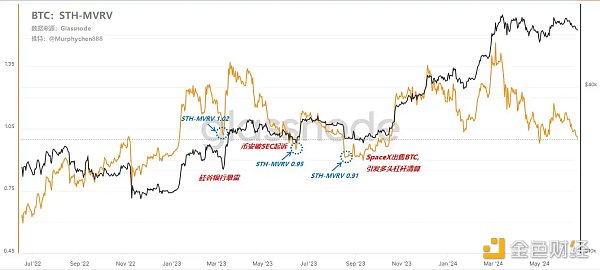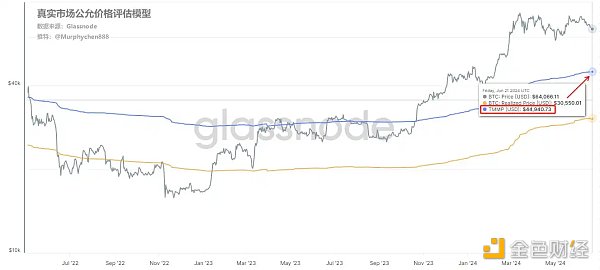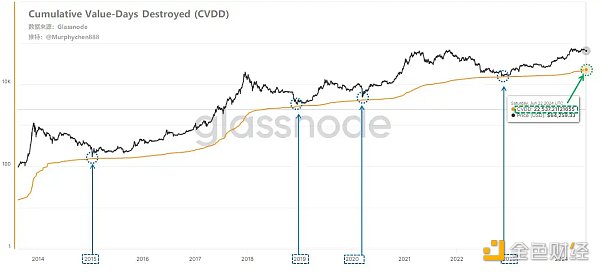Author: Murphy Source: X, @Murphychen888
From the analysis of on-chain behavior, how far may BTC fall in extreme cases in the bull market?
The overall logic is to evaluate from two aspects based on on-chain behavior analysis and historical data.
Method 1: From the perspective of STH-MVRV (short-term holders)
Short-term holders are important participants in the bull-bear transition, so the performance of STH-MVRV has extremely important reference value in the bull market cycle. I have used 2 tweets to explain its principles and functions in detail. New friends can refer to the following link, and I will not repeat it here.
For a detailed explanation of the role of STH-MVRV in the bull market, please refer to the following link: https://x.com/Murphychen888/status/1780825849962590374
For the important historical performance of STH-MVRV, please refer to the following link: https://x.com/Murphychen888/status/1781342103639130544
As we all know, there were two daunting black swan events in the last cycle, which also triggered a sharp drop in BTC prices. From the figure below, we can see that when the March 12 incident occurred, STH-MVRV was as low as 0.59; when the May 19 incident occurred, STH-MVRV was as low as 0.67. This means that on March 12, STH (short-term holders) had an average floating loss of 41%, and on May 19, STH (short-term holders) had an average floating loss of 33%. This shows how tragic the market was at that time.

In this cycle, there have also been 3 impressive market capitulation events:
1. On March 10, 2023, Silicon Valley Bank collapsed, and the price of BTC fell from US$25,000 to US$20,000. During this period, STH-MVRV dropped to a minimum of 1.02;
2. On June 5, 2023, Binance was sued by the SEC, and the price of BTC fell from US$30,000 to US$25,000. During this period, STH-MVRV dropped to a minimum of 0.95.
3. On August 17, 2023, it was reported that SpaceX sold $373 million worth of BTC, triggering long leverage liquidation. During this period, STH-MVRV dropped to a low of 0.91;

The STH-MVRV values under these special events correspond to the current BTC prices as follows:
STH-MVRV 0.59 = $37,979
STH-MVRV 0.67 = $43,129
STH-MVRV 1.02 = $65,659
STH-MVRV 0.95 = $61,153
STH-MVRV 0.91 = $58,579
I wonder if you have noticed that when the market moves out of the bottom range of the bear market, we can use the performance of STH-MVRV to evaluate the volatility of market sentiment. The depth of the STH-MVRV retracement also reflects the magnitude of the impact of the event that caused the BTC price to fall.
For example, the COVID-19 pandemic swept the world in 2020. This was a severe test for human life and health. In the face of the survival crisis, no one could think about anything other than life, including investment. The impact of the 3.12 incident on the risk market was equivalent to a magnitude 9 earthquake. I think that in this round of bull market cycle, based on the current situation that can be predicted, the probability of a black swan event of the same level (affecting human survival) occurring again is almost zero. Therefore, it can be inferred that STH-MVRV will not reach 0.59, that is, the price of BTC will not reach $37,979 (negligible);
The cause of the 5.19 incident was the panic caused by the Chinese government's withdrawal of mining companies. Although it was also a black swan, it was not to the extent of "life-threatening". Therefore, STH-MVRV reached a minimum of 0.67, which is obviously better than the situation on 3.12. Therefore, I think that if the risk market is shaken by the US economic recession, its maximum level will be similar to that of 5.19. If this is used as a metric, the limit of BTC price retracement in this bull market cycle is around $43,129.
The current market's expectation of the postponement of the Fed's interest rate cut and the possibility of only one interest rate cut this year should have a similar impact on the crypto market as the "Silicon Valley Bank explosion" and "Binance FUD" events. Therefore, I still maintain the view in the previous long tweet that BTC is more likely to do a wide range consolidation in the C1 and C2 ranges (i.e., $60,000-64,000 and $66,000-70,000).
As of June 21, STH-MVRV is 0.99. In the bull market, when STH-MVRV is below 1, opportunities usually outweigh risks (only for BTC, not including ALT).
Method 2: From the perspective of the market fair price algorithm
We first need to introduce a new concept, namely "Real Market Fair Price (TMMP)", its algorithm and principle are as follows:
TMMP = (Realized Cap - Thermocap) / (Liveliness x Circulating Supply)
There are 3 basic concepts to understand in this formula:
1. Realized Cap:
Each UTXO is valued at the corresponding price at the time of the last move, and the value of all unspent UTXOs in the network is accumulated and summed to obtain the Realized Cap. Because it takes into account the last move time and price of each Bitcoin, it more accurately reflects the total capital investment that actually flows into the BTC market.
2. Thermocap:
Also called total security expenditure, it is the sum of the dollar value of all block rewards (including block rewards and transaction fees) when miners receive them.
3. Liveliness:
It is the ratio of Coin Days Destroyed to all generated Coin Days.
Coin Days (CD): It is calculated by multiplying the number of days each Bitcoin is held by its quantity. One Bitcoin held for one day is equal to one Coin Day.
Coin Days Destroyed (CDD): When a Bitcoin is spent, the Coin Days it holds are destroyed. That is, Coin Days Destroyed is the sum of the Coin Days of all Bitcoins spent.
The numerator of the TMMP algorithm is Realized Cap minus Thermocap, which means that the portion of the total capital flowing into the BTC market that is paid to miners is deducted from the general cost basis of the market. The denominator is Liveliness multiplied by the circulating supply, which represents the number of all active BTC (spent) at present.
It covers all active chips on the chain, including ETFs, whales, transfers in and out of exchanges, etc., and excludes the miners, and does not include long-term dormant or lost chips. Therefore, using TMMP as the on-chain cost basis for evaluating active investors buying BTC in the secondary market is one of the most accurate mean reversion models for analysts seeking investors' on-chain holdings.

As shown in the above figure, the blue line is TMMP, and the gray line is the BTC price; whenever the BTC price stands on the blue line, it means that the market has exited the bear market and entered the bull market cycle. Although there will be false breakthroughs before this, after the effective breakthrough is finally formed, the price of BTC will hardly be lower than TMMP, even when the 5.19 black swan event occurred. But 3.12 is the only exception, which makes the price of BTC lower than TMMP again after entering the bull market cycle.
At the end of the bull market, once the BTC price falls below TMMP, it means the end of the bull market. In other words, as long as it is still in the bull market cycle, the price of BTC will not be lower than TMMP, unless a super black swan event (the level that affects human survival) occurs.

As of June 21, the "real market fair price" assessed by the TMMP model is $44,940. In other words, even if a black swan event similar to the 5.19 level occurs, the limit of BTC price retracement will be around $44,900. This price is close to the limit value of $43,129 assessed by STH-MVRV in the previous article, so I think this is a number worth referring to.
To sum up, we can draw some conclusions:
1. Under the premise that no super black swan occurs, even if BTC is affected by other macro factors, the limit of retracement will not be lower than 43,000-44,000;
2. The influence of the so-called super black swan must reach a major level that challenges human life (such as a nuclear war between Russia and Ukraine); obviously "US economic recession" is not enough.
3. Since it is a limit value, it means "it is highly unlikely to reach", not "it may reach".
4. The time period analyzed above is in the bull market cycle. If we enter the bear market, the limit standards of STH-MVRV and TMMP will become invalid;
In addition, I can make a more long-term prediction without shame: even at the bottom of the next bear market cycle, the price of #BTC will not be lower than $22,500. Although it does not mean much at present, it can tell us that the lower limit of BTC will get higher and higher over time. If the cost of the #BTC you hold is below this, please cherish it.
It is based on the CVDD algorithm:
CVDD (USD) = ∑(CDD × price) / (days × 6,000,000)

As shown in the figure above, CVDD depicts the historical bottom of BTC prices in each cycle with amazing accuracy. When BTC is transferred from one investor to another, the transaction not only has a dollar value, but also destroys the time value associated with the original investor's holding time of the token.
Its unique algorithm makes the value trend of CVDD continue to rise, that is, today's CVDD will definitely be higher than yesterday's and will never retreat. This is very effective for constructing a rising floor to the market bottom during a bear market where prices are falling!
 ZeZheng
ZeZheng










